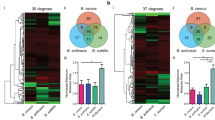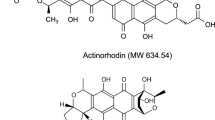Abstract
Glutathione is a nearly ubiquitous, low-molecular-mass thiol and antioxidant, but it is conspicuously absent from most Gram-positive bacteria. We identify here the structure of bacillithiol, a newly described and abundant thiol produced by Bacillus species, Staphylococcus aureus and Deinococcus radiodurans. Bacillithiol is the α-anomeric glycoside of L-cysteinyl-D-glucosamine with L-malic acid and most probably functions as an antioxidant. Bacillithiol, like the structurally similar mycothiol, may serve as a substitute for glutathione.
This is a preview of subscription content, access via your institution
Access options
Subscribe to this journal
Receive 12 print issues and online access
$259.00 per year
only $21.58 per issue
Buy this article
- Purchase on Springer Link
- Instant access to full article PDF
Prices may be subject to local taxes which are calculated during checkout


Similar content being viewed by others
References
Held, K.D. & Biaglow, J.E. Radiat. Res. 139, 15–23 (1994).
Fahey, R.C. & Sundquist, A.R. Adv. Enzymol. 64, 1–53 (1991).
Meister, A. in Glutathione: Chemical, Biochemical, and Medical Aspects part A (eds. Dolphin, D., Poulson, R. & Avramovic, O.) 367–474 (Wiley, New York, 1989).
Fahey, R.C., Brown, W.C., Adams, W.B. & Worsham, M.B. J. Bacteriol. 133, 1126–1129 (1978).
Jothivasan, V.K. & Hamilton, C.J. Nat. Prod. Rep. 25, 1091–1117 (2008).
Newton, G.L., Buchmeier, N. & Fahey, R.C. Microbiol. Mol. Biol. Rev. 72, 471–494 (2008).
Rawat, M. & Av-Gay, Y. FEMS Microbiol. Rev. 31, 278–292 (2007).
Newton, G.L. et al. Eur. J. Biochem. 230, 821–825 (1995).
Patel, M.P. & Blanchard, J.S. Biochemistry 38, 11827–11833 (1999).
Fahey, R.C. & Newton, G.L. in Functions of Glutathione: Biochemical, Physiological, Toxicological and Clinical Aspects (eds. Larsson, A., Orrenius, S., Holmgren, A. & Mannervik, B.) 251–260 (Raven, New York, 1983).
delCardayré, S.B., Stock, K.P., Newton, G.L., Fahey, R.C. & Davies, J.E. J. Biol. Chem. 273, 5744–5751 (1998).
delCardayré, S.B. & Davies, J.E. J. Biol. Chem. 273, 5752–5757 (1998).
Nicely, N.I. et al. Biochemistry 46, 3234–3245 (2007).
Lee, J.W., Soonsanga, S. & Helmann, J.D. Proc. Natl. Acad. Sci. USA 104, 8743–8748 (2007).
Soonsanga, S., Lee, J.W. & Helmann, J.D. Mol. Microbiol. 68, 978–986 (2008).
Rotzoll, N., Dunkel, A. & Hofmann, T. J. Agric. Food Chem. 53, 4149–4156 (2005).
Hermansson, K., Kenne, L., Rukunga, G.M. & Samuelsson, G. Phytochemistry 29, 513–515 (1990).
Lithgow, J.K., Hayhurst, E.J., Cohen, G., Aharonowitz, Y. & Foster, S.J. J. Bacteriol. 186, 1579–1590 (2004).
Wallen, J.R., Paige, C., Mallett, T.C., Karplus, P.A. & Claiborne, A. Biochemistry 47, 5182–5193 (2008).
Hoch, J.A. & Coukoulis, H.J. J. Bacteriol. 133, 265–269 (1978).
Mostertz, J., Hochgrafe, F., Jurgen, B., Schweder, T. & Hecker, M. Proteomics 8, 2676–2690 (2008).
Holmgren, A. Annu. Rev. Biochem. 54, 237–271 (1985).
Acknowledgements
We thank H. Upton for technical assistance. This work was supported by grants from the US National Science Foundation to R.C.F. (MCB0235705) and J.D.H. (MCB0640616); from the US National Institutes of Health to R.C.F. (AI49174 and AI072133), to M.R. (GM061223-05A) and to A.C. (GM35394); and from The University of East Anglia to V.K.J.
Author information
Authors and Affiliations
Contributions
M.R. and G.L.N. prepared bacterial cultures for isolation of 8 and the survey of thiol distribution. G.L.N. and T.B. purified 8; G.L.N. conducted the hydrolysis of 8 and the HPLC and enzymatic analyses. J.J.L. and G.L.N. conducted the NMR analysis of 8, 11 and 12. V.K.J. and C.J.H. synthesized proposed hydrolysis intermediates 11 and 12. G.L.N., M.R., J.J.L., C.J.H., A.C., J.D.H. and R.C.F. developed the project and interpreted the results. All authors contributed to the writing.
Corresponding author
Ethics declarations
Competing interests
G.L.N., M.R., J.J.L. and R.C.F. will attempt to patent bacillithiol, its biosynthetic precursors, and its biosynthetic and metabolic proteins.
Supplementary information
Supplementary Text and Figures
Supplementary Figures 1–3, Supplementary Tables 1–4 and Supplementary Methods (PDF 2812 kb)
Rights and permissions
About this article
Cite this article
Newton, G., Rawat, M., La Clair, J. et al. Bacillithiol is an antioxidant thiol produced in Bacilli. Nat Chem Biol 5, 625–627 (2009). https://doi.org/10.1038/nchembio.189
Received:
Accepted:
Published:
Issue Date:
DOI: https://doi.org/10.1038/nchembio.189
This article is cited by
-
Unique alcohol dehydrogenases involved in algal sugar utilization by marine bacteria
Applied Microbiology and Biotechnology (2023)
-
Pharmacological evaluation of disulfiram analogs as antimicrobial agents and their application as inhibitors of fosB-mediated fosfomycin resistance
The Journal of Antibiotics (2022)
-
Dietary thiols accelerate aging of C. elegans
Nature Communications (2021)
-
Underground metabolism facilitates the evolution of novel pathways for vitamin B6 biosynthesis
Applied Microbiology and Biotechnology (2021)
-
Bacillus pumilus KatX2 confers enhanced hydrogen peroxide resistance to a Bacillus subtilis PkatA::katX2 mutant strain
Microbial Cell Factories (2017)



